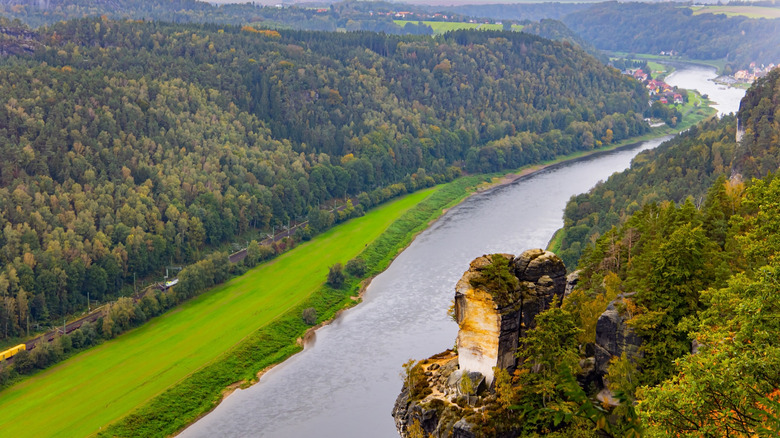One Of Germany's Prettiest National Parks Is An Underrated Gem With Unique Landscapes
Germany is a nation of hiking enthusiasts, with more than 186,000 miles of trails traversing the country, offering a lifetime of discoveries, beauty spots, and brushes with the past. And one of the most fantastic destinations for hikers as well as day trippers, cyclists, canoeists, and more, is the somewhat confusingly named Saxon Switzerland National Park, or, Nationalpark Sächsische Schweiz as it is known in German.
Located to the east of the historic city of Dresden in the state of Saxony just before the Czech border, Saxon Switzerland offers some of Germany's most breathtaking landscapes, mountain hikes, and riverside retreats, making it a great place to recharge from hectic city life or reconnect with nature. The region has been a source of inspiration for artists for generations, with painter Caspar David Friedrich, author Wilhelm Leberecht Götzinger, and film director Wes Anderson all being enchanted by Saxon Switzerland. It is slowly becoming a must-visit destination for tourists from Germany and beyond, rivalling the "Caribbean of the Alps" Grüner See for its natural beauty and Germany's UNESCO World Heritage Sites for its historical significance.
Hike the picturesque 'Painter's Way
"Be prepared to see from now on an uninterrupted series of natural beauties and rarities, which increase in size, beauty and scope the further you go," wrote Wilhelm Leberecht Götzinger of Saxon Switzerland in 1804. "The eye will have a feast for several days and so amply nourish mind and heart" (via Saxon Switzerland). But the destination was famous for its beauty long before the author penned these glowing phrases, and has maintained its reputation thanks to the jaw-dropping and unique landscape.
The Saxon Switzerland National Park website notes that it is the only rock national park in the country, and what stands out more than anything are the enormous towers of stone that shoot into the sky on the northern side of the River Elba, which today holds sway as one of the area's most popular attractions. Known as the Elba Sandstone Mountains, they are best accessed by historic hiking routes such as the Malerweg, or Painter's Way, which also provides incredible views of the surrounding forests and tabletop mountains. The Malerweg starts in the village of Liebethal near Dresden and stretches southeast toward Prague on the north side of the Elbe before crossing over and bringing hikers back along the southern shore, a route of just over 70 miles.
Don't miss the Basteibrücke, and other cultural attractions
The Malerweg has been described as the most beautiful hiking route in the whole of Germany. Indeed, as well as its unique rocky landscape, it is known among nature lovers for its unusual amount of biodiversity, a result of the area being home to several contrasting microclimates.
But there are other attractions that make Saxon Switzerland memorable, most notably the Basteibrücke, or Bastei Bridge, a 19th-century monument built in the heights of the Elba Sandstone Mountains that is undoubtedly the area's most famous beauty spot and biggest tourist attraction, having featured briefly in Wes Anderson's "The Grand Budapest Hotel." The rocks into which the bridge is cut were once the home of a medieval fortress, the remains of which are also explorable on foot. Other attractions in the area include the picturesque small towns and villages dotted along the River Elba. These include Bad Schandau — where many hikers arrive by train — Rathen, and Königstein, where visitors can find a range of restaurants and accommodation options.
Traveling to Dresden from Berlin? We'd recommend taking the longer route via the A9 to Leipzig, a highly underrated German city that has fewer crowds and lower prices than Berlin, but with the same bustling atmosphere. Leipzig is also easy to reach by train.


